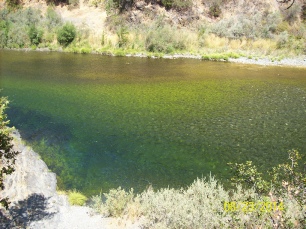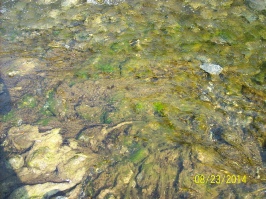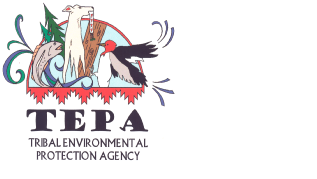


BACKGROUND
- The Hoopa Valley Tribe (HVT) applied for treatment as a state regarding the Water Pollution Control Program under the Clean Water Act (CWA) Section 106 on July 16, 1989.
- The United States Environmental Protection Agency (EPA) gave its formal approval of the application on July 3, 1990.
- HVT was the first tribe in California to receive such approval.
- The Hoopa Valley Tribal Environmental Protection Agency’s (TEPA) Water Quality Control Plan (WQCP) was approved September 11, 2002. Amendments were approved February 14, 2008.
- The Water Quality Control Plan includes water quality criteria, standards, anti-degradation policy, and implementation plans, in accordance with the Pollutant Discharge Prohibition Ordinance (PDPO).
- The PDPO states that protection of surface and ground water qualities for the use and enjoyment by the Hupa people requires control of the discharge of waste into waters of the Hoopa Valley Reservation.
The Tribal Council, in adopting the WQCP, intends for the Forest Management Plan, the PDPO, Riparian Protection and Surface Mining Ordinance, and other Plans and Ordinances developed to improve the waters of the Reservation to be implemented as anti-degradation policies. These Tribal regulatory documents are to be used as the mechanism to identify the actions needed to protect surface and ground waters of the Reservation.
GOALS
The purpose of TEPA’s water quality standards are to:
- Restore, maintain and protect the chemical, physical, biological, and cultural integrity of the surface waters of the Hoopa Valley Reservation;
- Promote the health, social welfare, and economic well-being of the Hoopa Valley Tribe;
- Achieve a level of water quality that provides for all potential uses; and to provide for full protection of threatened and endangered species.
The main objectives of TEPA’s monitoring efforts are to enable all of our water bodies to meet their respective designated uses. Collected data has and will continue to be used in development and implementation of future water quality standards, with an understanding of the unique characteristics of each water body with regard to natural water quality, existing and historical beneficial uses, and potential water quality problems and hazardous risks that may be posed to human health.
A number of streams within the Reservation are affected by certain land management practices including timber harvesting, cattle grazing, and runoff from agricultural pesticides (including those used on marijuana plots). TEPA is responsible for implementing measures to lessen the effects of these activities.
Monitoring the quality of all waters within the exterior boundaries of the Hoopa Valley Reservation is the responsibility of TEPA. This includes drinking water that must meet all applicable health-based standards. The following EPA goals to improve drinking water and water quality on American Indian Lands were described in their National Water Practices and End of Year Performance Report FY 2013. (SEE BELOW)
REPORTS
EPA National Water Program Guidance Addendum FY 2015
EPA Proposed Budget FY 2015 (Oct. 1, 2014 - Sept. 30, 2015)
Water Elements of EPA Strategic Plan FY 2014 - 2018
EPA GOALS are to protect and restore waters to ensure safe drinking water and that aquatic ecosystems sustain fish, plants, and wildlife and promote recreational and subsistence activities. Goals include:
- Taking Action on Climate Change and Improving Air Quality;
- Protecting America's Waters;
- Cleaning Up Communities and Advancing Sustainable Development;
- Ensuring the Safety of Chemicals and Preventing Pollution;
- Enforcing Environmental Laws.
Water Quality Control Plan Hoopa Valley Reservation 2002 - 2008
Case Studies in Tribal Water Quality Standards Programs - EPA 2006
Water Quality Monitoring by TEPA 2008-2012


The public drinking water systems regulated by EPA and delegated states and tribes, provide drinking water to 90 percent of Americans. Providing safe drinking water is a partnership that involves EPA, the states, tribes, water systems and their operators. Private, individual household wells, are not regulated by EPA.
Water pollution prevention and control measures are critical to improving water quality and reducing the need for costly wastewater and drinking water treatment. Because water pollution can come from many different sources, a variety of pollution prevention and control measures are needed to monitor and mediate the following:
- Under section 303(d) of the Clean Water Act, states, territories, and authorized tribes are required to develop lists of impaired waters. These are waters that are too polluted or otherwise degraded to meet the water quality standards set by states, territories, or authorized tribes. The law requires that these jurisdictions establish priority rankings for waters on the lists and develop TMDLs for these waters. A Total Maximum Daily Load, or TMDL, is a calculation of the maximum amount of a pollutant that a waterbody can receive and still safely meet water quality standards.
- Polluted runoff (nonpoint source pollution) is caused by rainfall and snowmelt moving over and through the ground that picks up and carries with it natural and human-made pollutants, depositing them into lakes, rivers, wetlands, coastal waters, and even our underground sources of drinking water.
- Sediments are fragmented materials originating from weathering and erosion of rocks or loose deposits that are transported by, suspended in, or deposited by water. Many sediments have been contaminated by pollution. Other types of sediments form on the bottom of natural water bodies and include dirt, soils, or other types of eroded materials. Sediments can negatively affect spawning salmon.
- The drinking water we receive from our local drinking water utilities or individual wells comes from ground water, streams, rivers, springs or lakes in a watershed. Although most water requires some treatment before use, protecting this source water is an important part of providing safe drinking water to the public.
- Stormwater runoff is generated when rain and snowmelt do not soak into the ground but flow over land or impervious surfaces, accumulating pollutants that could adversely affect water quality.
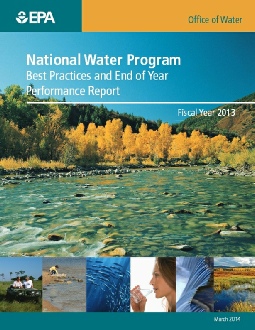
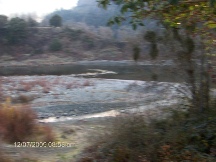
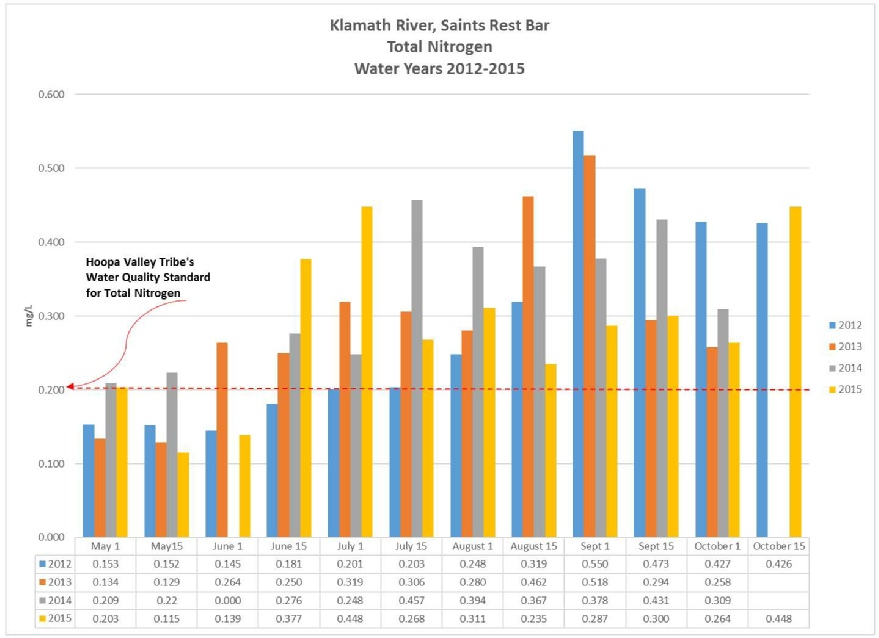
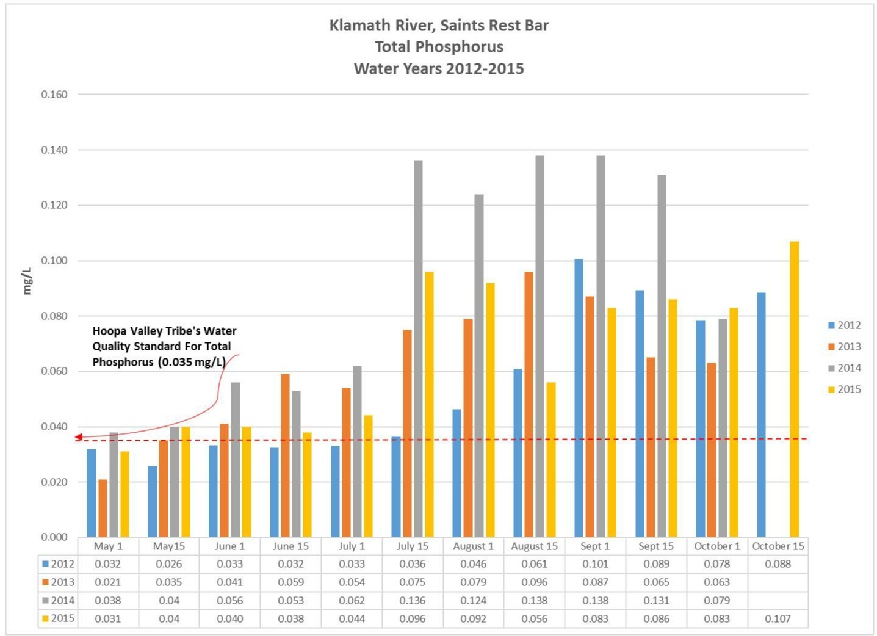

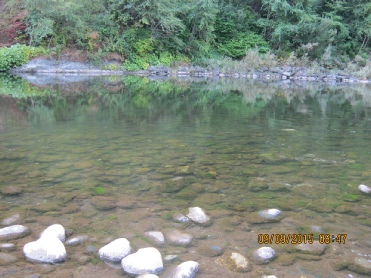
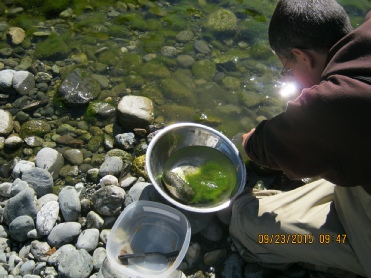
The Hoopa Valley Tribal EPA monitors Nutrients on the Klamath River at Saints Rest Bar from mid May to mid October. The graph for Water Years 2012 through 2015 show exceedances for both Total Nitrogen and Total Phosphorus from approximately mid June through the end of the sample season in October.
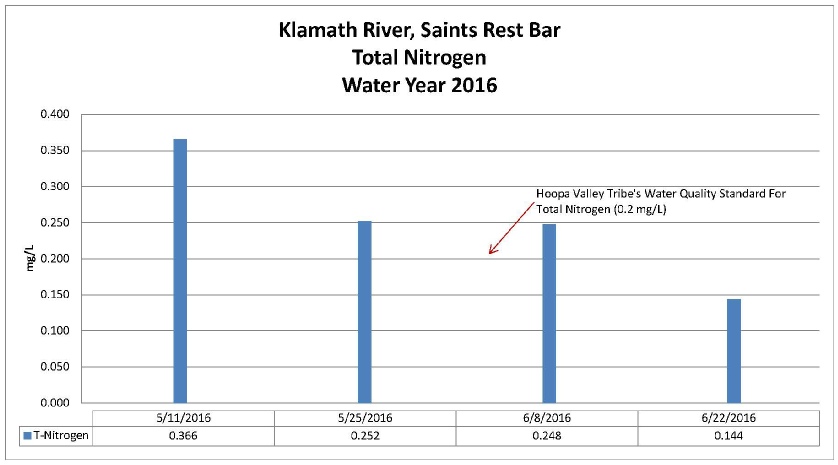
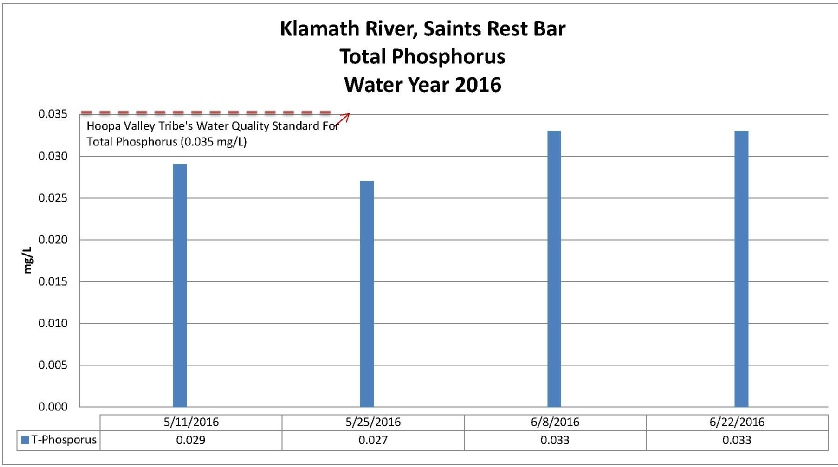

Klamath River “Saints Rest Bar”

The Hoopa Valley Tribal EPA monitors Nutrients on the Klamath River at Saints Rest Bar from mid May to mid October. For Water Year 2016, the data shows exceedances for Total Nitrogen from May 11th to June 8th. The graph for Total Phosphorus shows that the Klamath at Saints Rest remains under the threshold for this parameter.
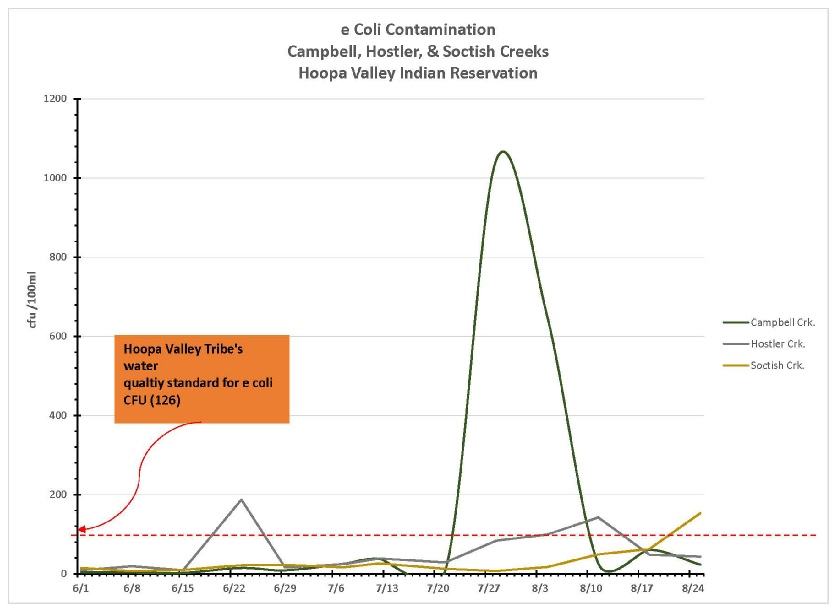

The Hoopa Valley Tribal EPA Collects E. Coli samples from six major tributaries to the Trinity River and at two locations on the Trinity River within the reservation boundaries. The graph below shows exceedances for Hostler, Campbell and Soctish creeks. TEPA monitors E. Coli as a safeguard for recreational users during the summer months from June 1st through October 1st. High E. Coli concentrations found in recreational waters can be attributed to illegal campsites too close to waterways, wild and domestic animals defecating in or near the water or refuse left by users including dirty diapers.
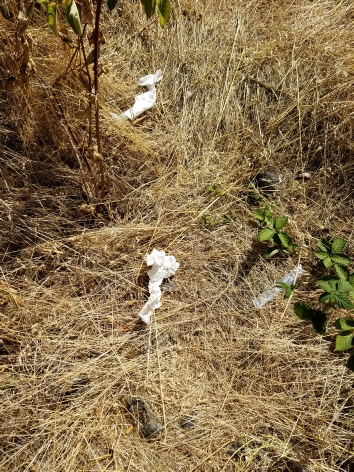

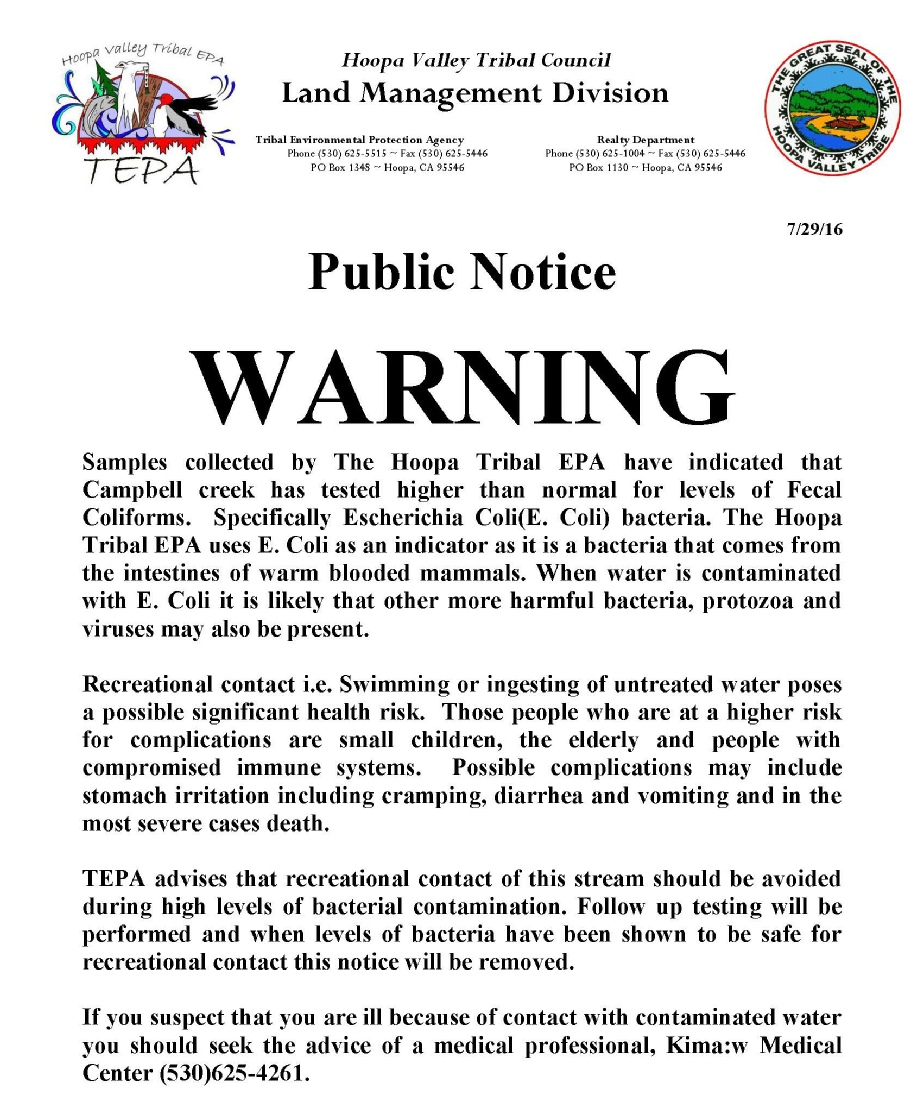
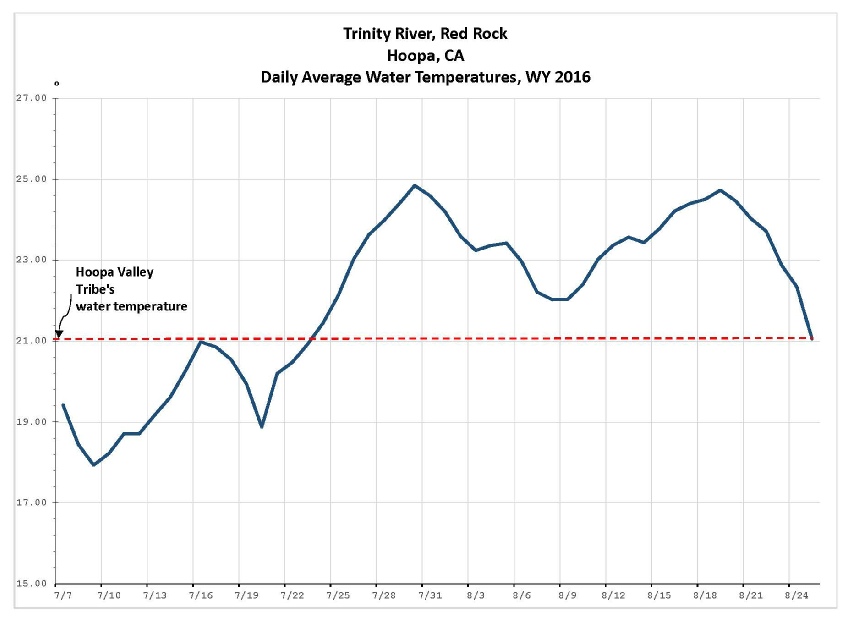

TEPA records Trinity River temperatures at the Red Rock Continuous Data Recorder (CDR) station from June 1st through October 15th. Current reading show high river temperatures for the period of 7/23/16 – 8/24/16. River temperatures above 21.1 °C exceeds the Hoopa Valley Tribe’s temperature standard for this time of the year, which poses a serious risk to salmon species migrating in the river.

Hoopa Trinity River Temperatures
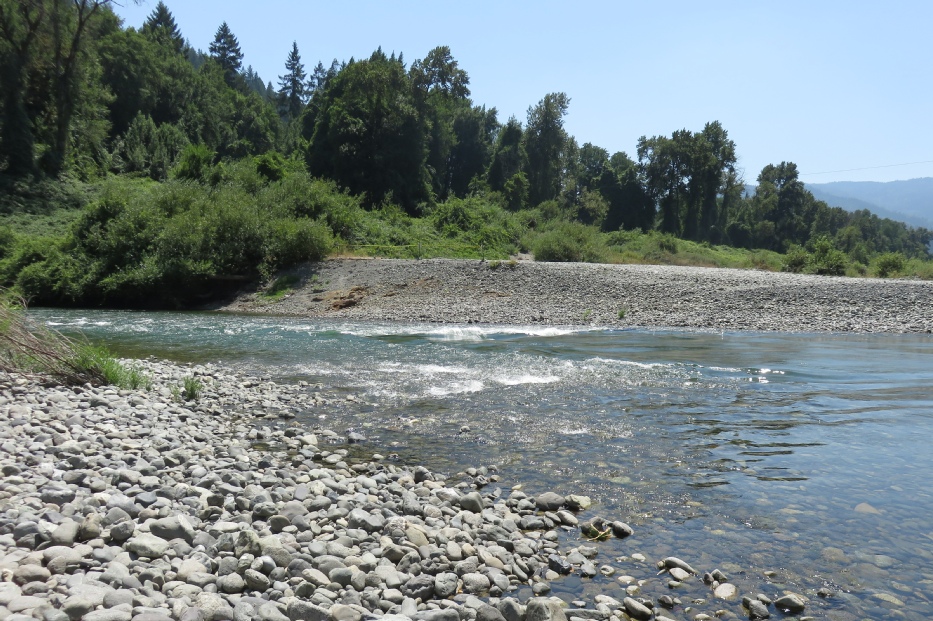

Redrock CDR Site
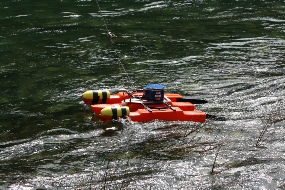
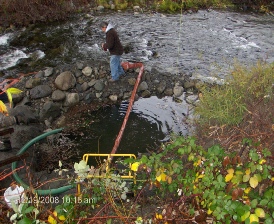


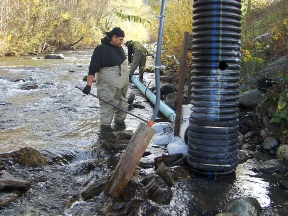
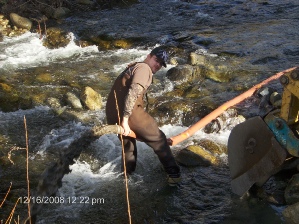
Blue-Green Algae Cyanobacteria
